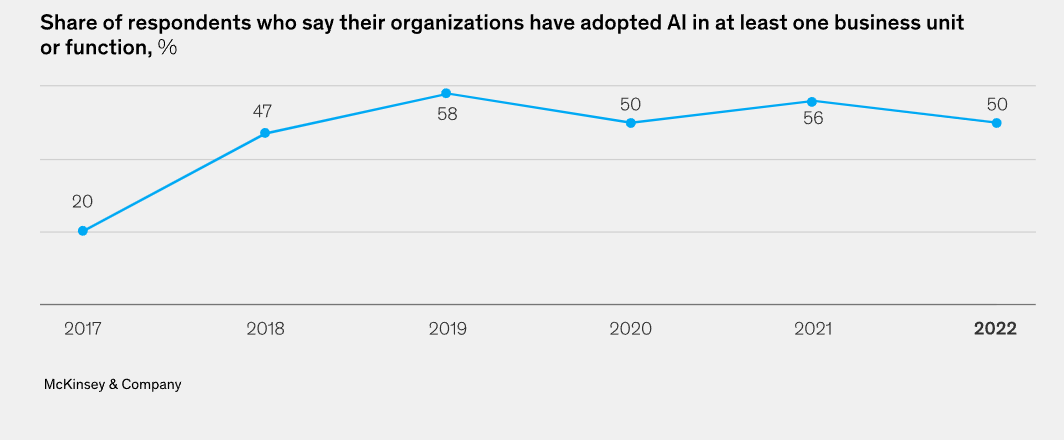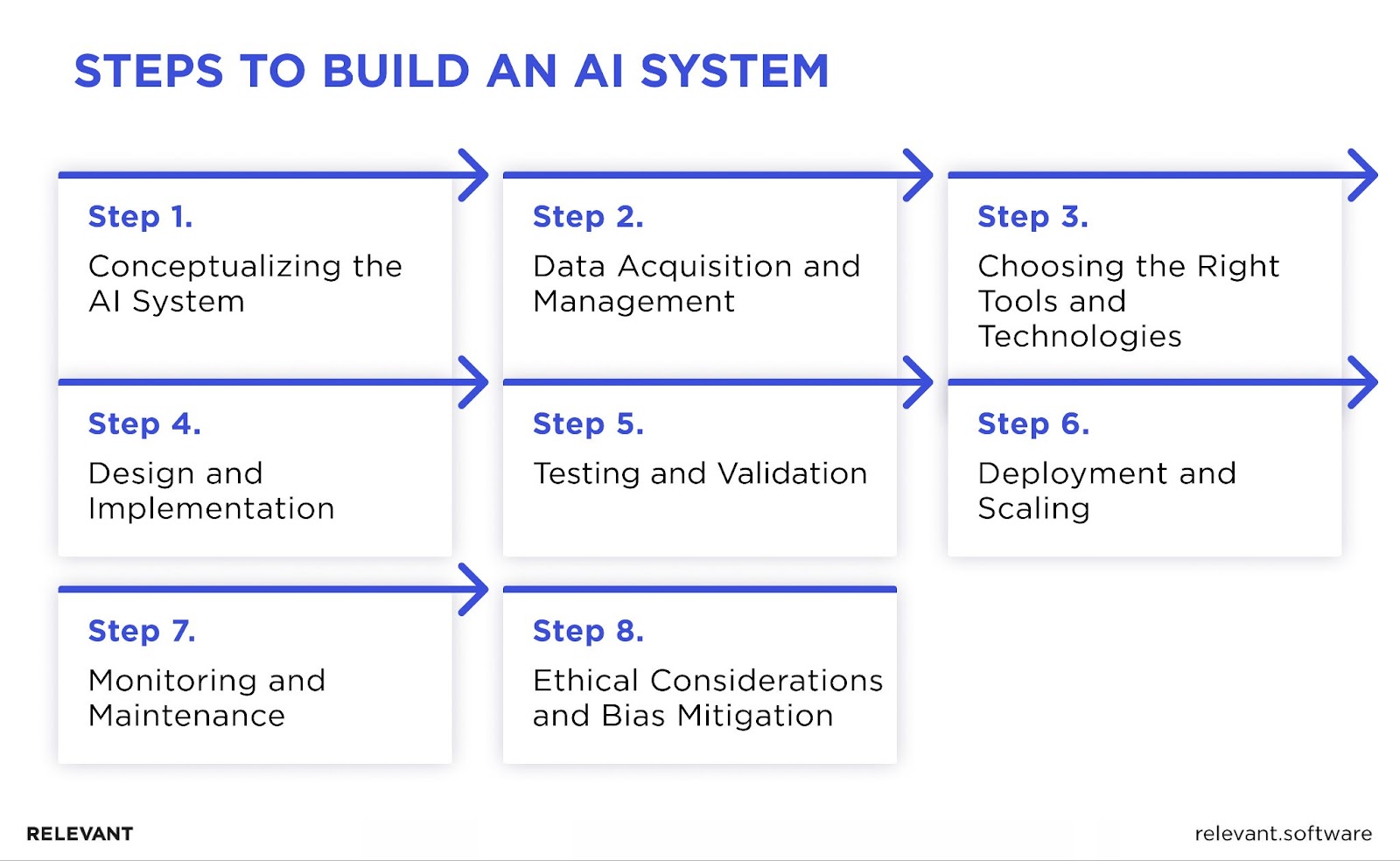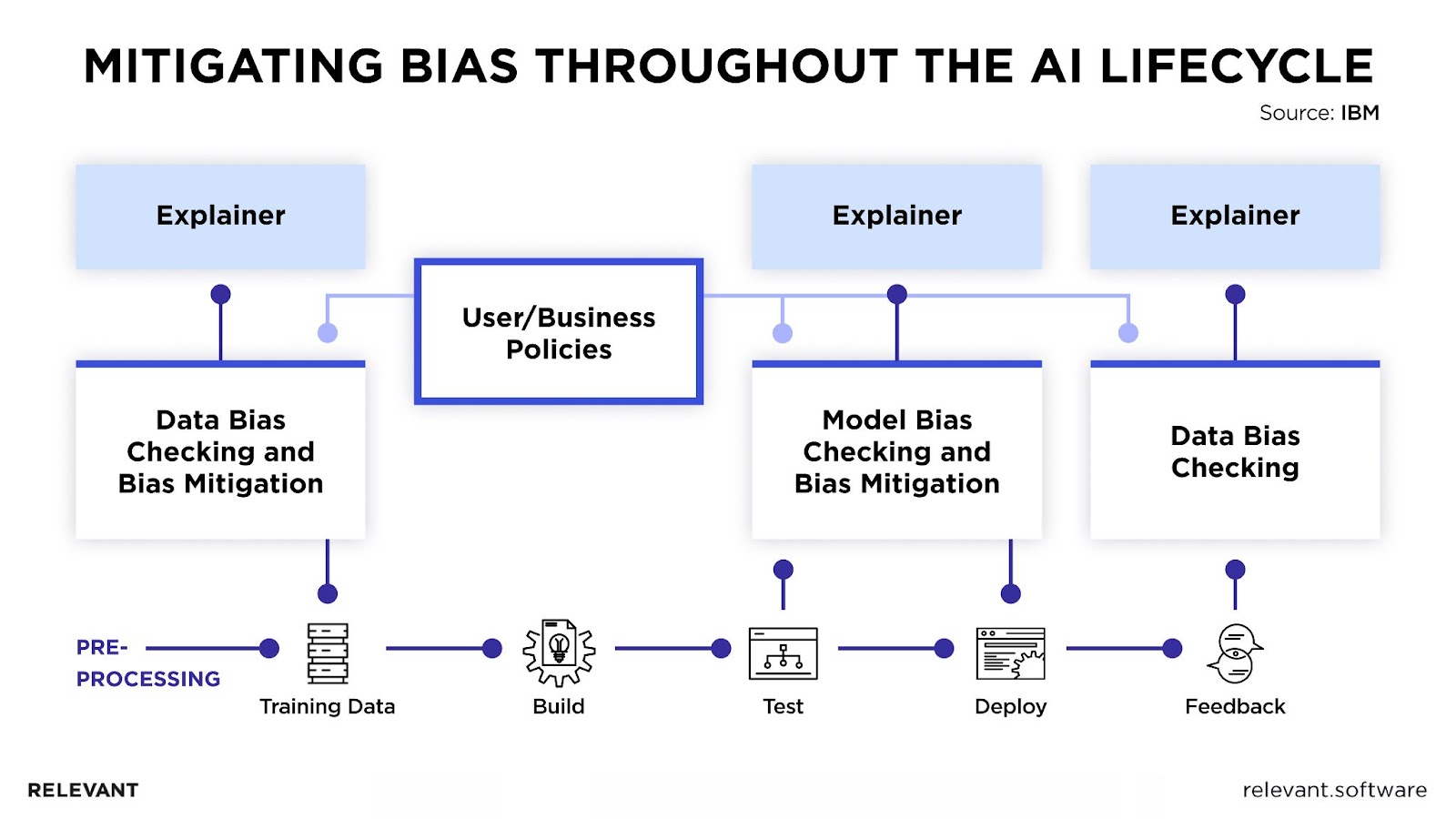How to Create an AI System: From Conceptualization to Deployment

Renowned professionals in the field draw parallels between the introduction of AI and pivotal inventions like the printing press or the first personal computer. This revolutionary technology has emerged as one of the foremost domains in software development, presenting immense growth opportunities. Notably, more than half of all businesses have already embraced AI in their operations, with 76% of enterprises indicating an escalation in AI investments in 2023. According to Statista’s data, projections anticipate the global AI market to reach an amazing value of nearly two trillion USD by 2030. But how to create an AI?
How does an idea evolve from a mere concept into a fully functional, intelligent solution? It must be hard, right? Actually, no – for specialists well-versed in the subject. At Relevant Software, we are proud to be among those with the expertise to explain the process to you. We will guide you through the pivotal stages of how to make an AI and the nuanced aspects of its conceptualization, design, implementation, and deployment. Ready? Let’s begin right away.
Artificial Intelligence: Overview
Artificial Intelligence (AI) is a revolutionary breakthrough in computer science and technology, reshaping the landscape with its transformative capabilities, exemplified by OpenAI’s ChtGPT. Its essence lies in creating machines and software capable of executing tasks that traditionally demand human intelligence. These tasks span various domains, including natural language processing, speech recognition, image analysis, and decision-making.

What is Artificial Intelligence (AI)?
In its fundamental essence, AI refers to emulating human intelligence processes by machines, particularly computer systems. It encompasses the creation of algorithms that enable machines to acquire knowledge from experiences, comprehend complex data, execute tasks, and arrive at decisions akin to human beings. This technology, thus, allows computers to mimic human cognition and perform tasks that typically require human intellect – from recognizing speech to diagnosing diseases and driving cars.
AI isn’t a monolithic entity but a vast field that comprises diverse sub-domains such as Machine Learning (ML), Deep Learning (DL), Natural Language Processing (NLP), and Robotics. Each of these domains represents different applications of AI, yet all share the goal of creating intelligent systems that can augment or automate human tasks.
Machine Learning (ML), a subset of AI, is perhaps the most well-known and widely used AI technique. Developing machine learning systems entails creating algorithms that enable computers to glean insights, make informed judgments, and forecast outcomes by leveraging data.
A further subset of ML is Deep Learning, which emulates the human brain’s learning process to progressively improve the machine’s ability to understand and interpret data. Deep learning algorithms use artificial neural networks with several layers of nodes (hence the term “deep”), mimicking the neural network structure of the human brain.
Different Types of AI Systems
One prominent categorization of AI systems distinguishes between narrow or weak AI and general or strong AI. Narrow AI refers to systems designed for specific tasks and functions, exhibiting intelligence only within those defined domains. Examples of narrow AI systems encompass voice-activated assistants like Siri or recommendation algorithms employed by online platforms.
In contrast, general AI represents the aspiration to create intelligent systems with the cognitive capabilities to understand, learn, and adapt across various tasks and domains, much like human intelligence. Nevertheless, attaining genuine general artificial intelligence (AI) continues to be an active area of research, fraught with numerous obstacles and intricate complexities that demand further exploration and resolution.
An alternative means of categorizing AI systems is by their learning methodologies. In supervised learning, models are trained using labeled data, enabling them to make predictions or classifications based on recognized patterns. Unsupervised learning focuses on extracting meaningful information and patterns from unlabeled data, allowing the system to identify inherent structures or relationships.
Reinforcement learning encompasses a process in which an agent acquires knowledge and skills by actively engaging with an environment. Through these interactions, the agent receives feedback through rewards or penalties, enabling it to optimize its behavior and decision-making capabilities.
These various AI systems highlight the breadth of possibilities and applications within the field. As technology advances and research progresses, the boundaries between different types of AI systems continue to evolve, fueling further innovation and pushing the limits of what AI can achieve.
Business Problems Solved With AI
Artificial Intelligence (AI) integration has proven to be a game-changer for businesses across numerous sectors, offering innovative solutions to address a wide range of challenges. This piece will robustly argue for the role of system AI in resolving some of the most pressing business concerns.
- Customer Service Enhancement: The advent of AI-driven chatbots and virtual agents has entirely redefined this domain. These intelligent systems tackle routine queries, proffer product suggestions, and expedite issue resolution, dramatically enhancing customer satisfaction and slashing costs.
- Data-driven Decision Making: AI platforms provide data analysis at a scale never seen before, equipping organizations with the necessary insights to make sound decisions. With the support of sophisticated analytics and machine learning, enterprises can glean valuable insights from big data sets, optimizing operations, pinpointing trends, and making increasingly accurate forecasts.
- Process Automation: Organizations that leverage AI capabilities can automate tedious, repetitive tasks, freeing up human capital to devote to strategic, innovative endeavors. Whether document processing, data entry, inventory management, or quality control, AI-fueled automation enhances operational efficacy, reduces errors, and accelerates procedures.
- Demand Forecasting and Inventory Optimization: AI algorithms allow businesses to scrutinize historical data, market fluctuations, and external influences to provide accurate demand forecasts and optimal inventory management. This use of AI in demand prediction and inventory management makes for a leaner supply chain, curtails costs, and boosts customer satisfaction.
- Fraud Detection and Risk Management: AI detects fraudulent activities by analyzing real-time patterns, anomalies, and multiple data sources. Fraud detection systems powered by AI can help organizations identify and prevent various types of fraudulent behaviors, safeguarding financial transactions and sensitive information.
- Personalized Marketing and Customer Experience: AI-driven personalization enables businesses to deliver tailored marketing campaigns and customer experiences. By analyzing customer data, preferences, and behavior, AI systems can recommend relevant products or services, create targeted advertisements, and provide personalized recommendations, enhancing customer engagement and loyalty.
- Optimized Resource Allocation: AI algorithms can optimize resource allocation in transportation, logistics, and energy management. Businesses can make smarter decisions, minimize costs, and reduce waste by analyzing data and considering variables like traffic patterns, weather conditions, and energy consumption.
By harnessing AI technologies and employing strategic approaches, businesses can attain a distinct advantage, optimize operational efficiency, elevate customer satisfaction, and open up new opportunities. The transformative potential of AI in solving complex business problems is undeniable, and organizations that embrace this technology stand to thrive in an increasingly data-driven and AI-powered future.

Source: Mckinsey
How to Create an AI from Scratch in 8 Steps
Understanding how to create an AI application involves a blend of machine learning expertise, sound programming skills, and deep knowledge of algorithms, all critical components for crafting intelligent and responsive solutions.
At Relevant Software, we follow a structured, end-to-end approach to constructing an artificial intelligence solution. This systematic methodology ensures we build effective, robust, and ethically sound AI systems tailored to our client’s unique needs. Here, we provide a glimpse into our eight-step process on how to create an AI program:

Step 1. Conceptualizing the AI System
The question of how to make AI revolves around the integration of advanced algorithms, machine learning models, and comprehensive data sets, which together form the core components of intelligent systems. The initial step to embark on the journey of building an AI involves:
Defining the Problem Statement
The foundation of any AI project is a clearly defined problem statement. We start by understanding the issue you wish to address using AI and then create a detailed action plan.
Identifying the Target Audience and Setting Clear Objectives
We identify your target audience and establish clear objectives for the AI system. This could include improving customer experience, streamlining business operations, or providing actionable insights from data. We then set quantifiable goals to measure the system’s success. The goals must be precisely specific, measurable, achievable, relevant, and time-bound- commonly known as SMART.
Assessing Feasibility and Budget Considerations
We evaluate the feasibility of your project by considering factors such as available resources, technical requirements, and potential roadblocks. We also assess your budget to ensure the AI project is cost-effective and delivers a high return on investment.
Step 2. Data Acquisition and Management
The next step in building an AI is acquiring a dataset, essentially the required data for implementation. In cases where the client does not possess an existing dataset, the project should allocate sufficient time for its creation or search and, at times, even labeling. A dedicated team of experts is necessary to mark the dataset, and we, as an AI development company, diligently select these experts individually.
Identifying Relevant Data Sources
Data is the lifeblood of AI. We identify relevant data sources that align with the problem statement and objectives. These sources could include internal (e.g., transaction records, customer databases) and external datasets (e.g., publicly available data, third-party data).
Collecting and Cleaning the Data
Our team meticulously collects the required data, then cleans and preprocesses it to eliminate any inconsistencies or inaccuracies, ensuring the data is fit for analysis. During preprocessing, we may also transform the data into a format our AI models can use more effectively. This can involve techniques like normalization, feature extraction, or data augmentation.
Ensuring Data Quality and Integrity
We uphold the highest standards of data quality and integrity. Verifying the data’s accuracy, completeness, consistency, and validity, we ensure that our AI models can generate reliable and insightful outcomes.
Step 3. Choosing the Right Tools and Technologies
It is a fundamental step when considering how to create an AI (artificial intelligence), as this decision directly impacts the efficiency, effectiveness, and adaptability of the AI solution. Building AI, Relevant Software employs a meticulous approach to ensure optimal technology selection for each project. Here’s how we do it:
Programming Languages
Our experts thoroughly analyze your project’s requirements to determine the best programming language. C++ excels at handling gamification complexities, while Python offers a gentle learning curve. If easy debugging is your priority, Java is a user-friendly option. Rest assured, we will find the perfect fit for your needs. Need more info? Read our article “Top Programming Languages For Artificial Intelligence”.
Libraries and Frameworks
We leverage libraries and frameworks like TensorFlow, PyTorch, and Keras. These powerful tools accelerate development, streamline model building, and improve overall performance. By harnessing the capabilities of these advanced libraries, we create AI models that deliver exceptional results.
Cloud Services
We harness the power of leading cloud service providers such as AWS, Azure, and Google Cloud to provide scalable, flexible, and cost-effective AI solutions. Leveraging the cloud infrastructure enables us to efficiently manage computational resources, store, and process large datasets, and seamlessly deploy AI systems.
Hardware Considerations
Also, our team carefully considers the computational requirements of your AI system. Based on these considerations, we select the appropriate hardware components, including GPUs (Graphics Processing Units), TPUs (Tensor Processing Units), and CPUs (Central Processing Units). This ensures that your AI models can handle the intensive computational tasks they entail, delivering optimal performance and efficiency.
Step 4. Design and Implementation
In the design and implementation phase, we translate the findings from our data analysis into actionable AI models. This crucial step requires expertise, precision, and a deep understanding of machine learning algorithms.
Selecting the Appropriate Algorithm
Whether it calls for supervised learning, unsupervised learning, or reinforcement learning methods, we meticulously analyze the characteristics of your data and tailor the algorithm accordingly. This meticulous selection ensures that your AI system has the optimal algorithm to tackle the problem.
Model Training and Evaluation
Our expert team leverages the cleaned and processed data to train our AI models meticulously. Through an iterative process, we fine-tune the models, ensuring they capture the underlying patterns and nuances in the data. The rigorous evaluation uses appropriate metrics to measure the models’ performance against the set objectives.
Hyperparameter Tuning
Understanding the significance of fine-tuning hyperparameters, we maximize model accuracy and robustness by systematically adjusting parameters like learning rate, regularization, and network architecture. In creating an AI, our expert data scientists employ cutting-edge techniques, including grid search and Bayesian optimization, to iteratively explore the hyperparameter space and identify the best configuration.
Handling Overfitting and Underfitting
Overfitting occurs when a model excessively fits the training data, leading to poor generalization. Underfitting, on the other hand, indicates insufficient learning and limited performance. At Relevant Software, we employ advanced techniques such as regularization, cross-validation, and ensemble methods to combat these issues effectively. We balance capturing patterns and ensuring the model’s generalizability by optimizing model complexity, collecting diverse data, and fine-tuning hyperparameters.

Step 5. Testing and Validation
Following the design and implementation phase, we advance into the testing and validation stage. This is an absolutely crucial step in our Artificial intelligence development process, serving as the litmus test for the robustness and reliability of the models we have designed and implemented.
Understanding Evaluation Metrics
As specialists in AI development, we prioritize validating the effectiveness of the models we build. This critical process hinges on using various evaluation metrics: accuracy, precision, recall, and the F1 score. It’s imperative to comprehend that these metrics aren’t simply digits. Rather, they offer profound insights into the model’s abilities and, perhaps more significantly, its limitations.
Cross-Validation Techniques
That’s where cross-validation techniques come into play. Far from a simple test run, these methods test the model’s mettle in different scenarios and data subsets. They are designed to scrutinize the model’s performance, ensuring it’s not merely a paper tiger but a robust solution capable of withstanding varied challenges.
Error Analysis
An integral part of our AI development process involves a detailed error analysis. While some may shy away from the prospect of errors, we welcome them. We view errors as tell-tale signs revealing the areas requiring enhancement. We interrogate these errors, uncover their root causes, and seize these opportunities to refine our models.
Interpreting Results and Insights
Finally, we emphasize interpreting the model’s results and extrapolating insights from these. Far from arcane number-crunching, these insights can bolster your business operations significantly. They’re the compass points that lead you to data-driven decisions, ensuring that your next strategic move isn’t based on gut feelings but informed by data.
Step 6. Deployment and Scaling
The deployment and scaling phase is a meticulously planned process involving model preparation, seamless integration with existing infrastructure, and designing scalable, reliable AI systems.
Preparing the Model for Deployment
Once the model meets our standards, we prepare it for deployment in a suitable environment – whether that’s cloud, on-premises, or at the edge. This highly customized procedure considers the model’s specifications, requirements, and the operational environment it is intended to function within.
Integrating the AI System with Existing Infrastructure
We seamlessly integrate the AI system with your existing infrastructure, ensuring it complements and enhances your current operations. The integration process is meticulously planned and executed, minimizing disruption while maximizing operational synergy.
Ensuring Scalability and Reliability
The design of our AI systems encompasses a future-focused perspective. We build systems not just for the current operational load but with a vision to accommodate future growth. The systems we develop are inherently scalable and capable of expanding to meet increased demand as your business grows.
Step 7. Monitoring and Maintenance
Undeniably, the journey of creating an AI system does not conclude at deployment; it is where the real work begins. One key aspect of our commitment to this journey involves setting up rigorous monitoring mechanisms.
Establishing Monitoring Mechanisms for the AI System
We remain vigilant and regularly evaluate the system’s performance within the production environment. This continuous scrutiny enables us to identify system functioning discrepancies and swiftly make necessary adjustments.
Continuously Evaluating the System’s Performance in Production
It isn’t a periodic check-up but a regular and rigorous process to maintain the highest performance standards. Regular evaluations allow us to remain proactive, identifying minor glitches before they escalate into significant problems. This oversight ensures your AI system continues functioning at its peak, delivering consistent value.
Updating and Maintaining the System to Adapt to Changing Requirements
We understand that business needs to evolve. Therefore, we provide regular updates and maintenance to the AI system, adapting it to meet your changing requirements.
Step 8. Ethical Considerations and Bias Mitigation
At Relevant Software, we understand that the neutrality of an AI model is directly dependent on the data it is trained on. Any discriminatory, unjust, or biased data can potentially translate into biased decisions.
Addressing Potential Biases and Fairness Issues
We actively identify and mitigate any biases that might be inherent in our data sets. Furthermore, we continually refine our algorithms to minimize the scope for prejudiced results.
Ensuring Data Privacy and Security
To guarantee the protection of your data, we have implemented comprehensive security measures. These measures include advanced encryption technologies, multi-factor authentication, and regular security audits. We adhere strictly to privacy regulations such as GDPR and CCPA, maintaining high ethical standards in data management.
Promoting Transparency and Explainability
We strive for transparency and explainability, creating AI systems. We aim to build models that explain their predictions clearly, making AI more accessible and trustworthy.

How to Create an AI: Common Mistakes and How to Avoid Them
In AI development, avoiding common pitfalls is crucial for success. Let’s explore some prevalent mistakes and effective strategies to sidestep them.
Overcomplicating the Model
Building AI applications often presents a common challenge: their complexity. While a sophisticated design may seem impressive, it can lead to poor performance, high resource consumption, and limited interpretability.
Solution: The key is to strike a balance between model complexity and functional effectiveness. The focus should be on identifying and optimizing essential features to achieve superior performance. By prioritizing simplicity and effectiveness, we can unlock the true potential of AI models.
Ignoring Data Quality
Poor data quality can lead to inaccurate predictions, skewed outcomes, and a confined sphere of real-world relevance.
Solution: Committing substantial time and resources to data preprocessing, cleansing, and validation processes becomes essential. Ensuring data quality consistency throughout the system’s life cycle is indispensable for robust and reliable performance.
Overlooking Security
Despite the paramount importance of security in AI development, it is frequently overlooked. The repercussions of disregarding security considerations are severe, potentially resulting in unauthorized data access, breaches, and privacy violations.
Solution: Incorporating stringent security measures – including but not limited to encryption, access controls, and secure data handling practices – is a necessary course of action. These precautions protect sensitive information and fortify the system against potential threats.
By cultivating an awareness of these common errors and adopting the respective corrective strategies, organizations can significantly augment the success rates of their AI initiatives. Doing so ensures the provision of AI systems that are not only productive and secure but also maintain high-quality standards in performance and reliability.
How to Create an AI: Our Use Cases and Advice
At Relevant Software, we have an established track record of deploying Artificial Intelligence (AI) solutions in diverse industries. A particular instance of our successful collaboration in this field is our project with Superface AI. We successfully conducted the discovery phase during this partnership and scripted the Application Programming Interface (API) for several payment platforms. We invite you to delve into the details in our Superface AI case study, available on our website.
Our wide-ranging expertise and in-depth understanding of AI and Machine Learning (ML) equip us with the knowledge and skills to offer strategic guidance in applying these technologies within your business framework. Here are key considerations to bear in mind when implementing AI:
- Shift the focus from AI being a mere feature to positioning it as a strategic asset in your business. Avoid using it merely as a marketing tool; instead, focus on its role in enhancing your customers’ or partners’ existing processes.
- Utilize human-in-the-loop AI technologies collaboratively with enterprise partners. Combining AI’s strength in processing large data volumes with human expertise for decision-making under uncertain conditions can result in efficient problem-solving.
- Equip yourself with a clear understanding of AI concepts. Despite its widespread use, misconceptions about AI persist. Being knowledgeable allows you to address these misconceptions effectively when engaging with stakeholders.
Remember, confidently presenting AI as a valuable resource, collaborating with humans for problem-solving, and effectively communicating its concepts will position you as a trusted authority in your field and help you forge meaningful connections with your target audience.

The Future of AI Development
As AI technologies continue to evolve at an accelerating pace, we can anticipate significant developments that will shape the landscape of AI in the years to come. Here are some key areas where we can expect noteworthy progress:
- Explainable AI: Efforts are underway to develop AI systems that provide transparent explanations for their decisions. This is vital in critical fields like healthcare and finance, ensuring accountability and compliance.
- AI for Edge Computing: AI models designed for edge computing bring AI capabilities closer to the data source, enabling real-time decision-making without heavy reliance on cloud infrastructure.
- Ethical AI Governance: Strengthening regulations and guidelines is crucial to ensure the ethical development, deployment, and utilization of AI systems, safeguarding fairness, accountability, and privacy.
- AI-Augmented Creativity: AI tools and algorithms are being developed to amplify creativity in domains such as design, music, and storytelling. These innovations push the boundaries of human imagination and enable new forms of artistic expression.
- AI as a Service (AIaaS): AIaaS platforms offer on-demand access to AI capabilities, tools, and resources. Users can leverage existing AI platforms and frameworks provided by specialized vendors, eliminating the need for extensive AI infrastructure investment.
Embracing the potential of AI opens up unprecedented opportunities for growth, innovation, and success. As your trusted and dedicated partner in AI development and implementation, we invite you to join us on this transformative journey.



